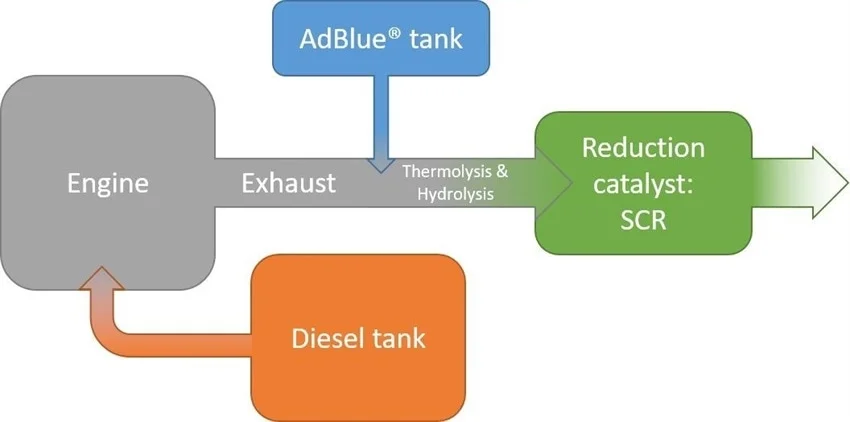Product Detail
20 Ltr. Bottled shield packing Aus32/Exhaust Gas Cleaner.
VCPL’s Exhaust Gas Cleaner is a liquid used to reduce the amount of air pollution created by a diesel engine. Specifically, DEF is an aqueous urea solution made with 32.5% urea and 67.5% deionized water. DEF is consumed in a selective catalytic reduction (SCR) that lowers the concentration of nitrogen oxides (NOx) in the diesel exhaust emissions from a diesel engine and Diesel heavy engine. AdBlue is used in vehicles with a Selective Catalytic Reduction catalyst, or SCR. An SCR catalyst ensures that exhaust gases are treated before they leave the vehicle. A large proportion of the heavy-duty vehicles complying with the Euro 4, Euro 5 and Euro 6 standards are equipped with an SCR system and therefore use AdBlue. This applies to most trucks after 2005; the first passenger cars with diesel engines and SCR were introduced in response to the Euro 6 standard in 2014.
An SCR is located behind the particulate filter in the exhaust. When a certain amount of NOx wants to enter the catalyst, a measured dose of AdBlue is injected from the AdBlue reservoir. The AdBlue is converted by the SCR catalyst into ammonia and a small amount of carbon dioxide. The formed ammonia reacts with the NOx, creating the non-hazardous substances nitrogen and water. The SCR catalyst ensures that this reaction takes place quickly and sufficiently.


APPLICATION
VCPL’s Exhaust Gas Cleaner is recommended for modern BS6/BS4 vehicles in medium and heavy-duty vehicle. used in various Trucks & Buses and Earth mover. Also used diesel engine in Medium sized vehicle and SUV’s or any other BS4/BS6 vehicle.
STANDARD MEET AND FOLLOWUPS
- ISO 22241-1: 2019
- IS :17042(PART 1): 2020
TYPICAL CHARACTERISTCS
| No. | Name | Method | Units | VCPL DEF |
|---|---|---|---|---|
| 1 | Appearance | Visual | - | Clear Liquid |
| 2 | Color | Visual | - | Colorless |
| 3 | Density | ISO 12185 | g/cm3 | 1.09 |
| 4 | Urea Content | ISO 22241-2 (B & C) | % By Weight | 31.8-33.2% |
| 5 | Refractive Index | ISO 22241-2 (C) | - | 1.38 |
| 6 | Total Alkalinity | ISO 22241-2 (D) | % | < 0.2 |
| 7 | Biuret | ISO 22241-2 (E) | mg/kg | < 0.3 |
| 8 | Aldehyde content | ISO 22241-2 (F) | mg/kg | < 5.0 |
| 9 | Insoluble Matter | ISO 22241-2 (G) | mg/kg | < 20 |
| 10 | Phosphate, %wt | ISO 22241-2 (H) | %wt | < 0.00005 |
| 11 | Calcium, % wt | ISO 22241-2 (I) | %wt | < 0.00005 |
| 12 | Iron, %wt | ISO 22241-2 (I) | %wt | < 0.00002 |
| 13 | Copper, % wt | ISO 22241-2 (I) | %wt | < 0.00002 |
| 14 | Nickel, % | ISO 22241-2 (I) | %wt | < 0.00002 |
| 15 | Aluminum, % wt | ISO 22241-2 (I) | %wt | < 0.00005 |
| 16 | Magnesium, % wt | ISO 22241-2 (I) | %wt | < 0.00005 |
| 17 | Sodium, %wt | ISO 22241-2 (I) | %wt | < 0.00005 |
| 18 | Potassium, % wt | ISO 22241-2 (I) | %wt | < 0.00005 |
FEATURES & BENEFITS
- Superior protection for the SCR catalyst
- Prevents fouling/clogging of Spray nozzles
- Prevents gummy deposits in the tailpipe
Environment Benefits of AdBlue
AdBlue aims to significantly reduce emissions of nitrogen oxide (NOx) which are harmful to the environment and thus meet the stringent emission limits set by European standards (Euro 6) - which are standard for the control of emissions of new vehicles sold in the European Union and America.
AdBlue fluid treatment is injected into the exhaust gases and can filter out more than 90% of the harmful gas emissions of nitrogen oxide into steam and nitrogen, resulting in less pollution.
How much AdBlue fluid is needed?
Although tanks are filled every six months during maintenance, the rate at which cars use AdBlue varies depending on how economically they are driven, engine size and overall/average mileage. The average consumption of AdBlue is about one liter per 1,000 km but can reach up to one liter every 550 km. This means that fleet drivers who use the road more will need a better understanding of AdBlue than the standard driver.
But do not panic because all vehicles with this system have a warning system in the dashboard that will inform you when it is necessary to fill the AdBlue tank. It also monitors the level of AdBlue in the tank. And if the tank is empty, the engine will not start!
Refilling AdBlue in your vehicle
It is recommended that refills are provided by specialized technicians. If you choose to refuel, do not allow the fluid to meet the skin and be careful to avoid any spills as this may damage the paintwork of the car. If this happens, clean the area where you spilled the AdBlue and if necessary, wash the area with water. If spilled on clothing and hands, just rinse thoroughly with clean water.
Regular refueling of your AdBlue guarantees both a more environmental and efficient driving experience.
If you have a fleet of diesel vehicles that require AdBlue, you can set Frotcom to trigger the AdBlue low-level alarm.
STORAGE INSTRUCTIONS AND RECOMMENDATIONS
- Keep away product from direct sunlight.
- Keep away product from dust and dirt also maintain temperature between -10°C to +20°C For best self-life.
IMPORTANT INSTRUCTIONS
- Do not fill into other than AdBlue/def tank.
- Avoid contamination with any other substance.
- Use Funnel for handling and filling VCPL’s Exhaust Gas Cleaner.
- Do not store in any other used substances bucket or container it will add impurity in VCPL’s Exhaust Gas Cleaner.
